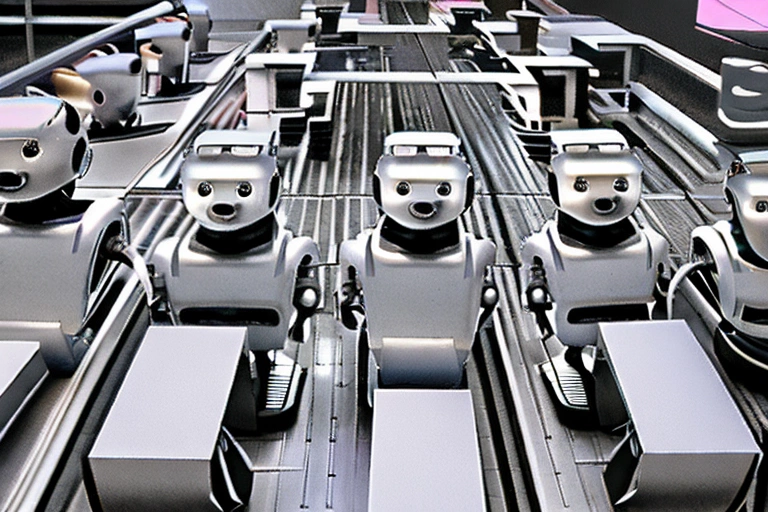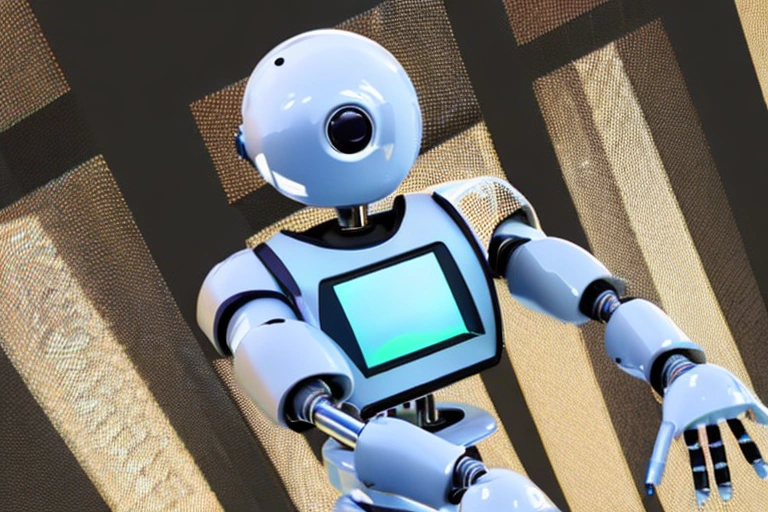Are you looking for a way to make your daily chores easier? If you have ever wondered what it would be like to have a self-operating robot working for you, then this blog post is for you. We will explore the cost of having a self-operating robot working for you, as well as the many benefits that come along with it. So, how much does it cost? Read on to find out!
What is AI and How Does It Impact Robotics?
Artificial intelligence (AI) is a field of computer science that deals with the creation of intelligent agents, which are systems that can reason, learn, and act autonomously. Robotics technology has been greatly impacted by AI, as robots are now able to interact with their surroundings in a more natural way. For example, a self-driving car relies on AI to make decisions about where to go and how to get there.
The impact of AI on robotics is likely to continue to grow in the future. As AI becomes more sophisticated, it will be able to help robots perform more complex tasks and navigate difficult environments. This could lead to significant improvements in the efficiency and accuracy of robotic systems.
Benefits of Having a Self-Operating Robot Working for You
There are many benefits to having a self-operating robot working for you. Not only can they save you time and effort, but they can also be incredibly accurate and efficient. In addition, they can be customized to meet your specific needs, making them an invaluable tool in your workplace.
Types of Machines with AI Capabilities
There are many types of machines with AI capabilities, and the price range for each type can vary significantly. For example, a self-operating robot may cost less than a machine with AI capabilities that is operated by a human. On the other hand, a machine with AI capabilities that can autonomously navigate a complex environment may cost more than a machine without AI capabilities.
The Average Cost of Robots with Artificial Intelligence
The average cost of robots with artificial intelligence varies depending on the type of robot and the features included. However, the average cost for a humanoid robot is about $10,000. For a robot with more advanced capabilities, such as facial recognition and natural language processing, the price can range from $20,000 to $100,000.
Factors to Consider When Deciding On a Budget
When deciding on the budget for a self-operating robot, it is important to consider factors such as how many hours of usage per day and year the robot will require. Additionally, it may be helpful to factor in the price of replacement parts or services.
Where to Buy Automation Robots With Artificial Intelligence
Looking to add some automation to your business operations but unsure where to start? Fear not, as there are a number of ways to get robots with AI working for you without breaking the bank. Popular providers like Amazon and Google offer large robot fleets that can be rented or leased on a monthly basis. Alternatively, you could purchase pre-made robots from specialist dealerships or online stores.
Whatever route you choose, make sure you consider factors such as price and function when making your decision. Although larger, more expensive robots will typically have more capabilities, it’s important not to forget about affordability when choosing one. In addition, keep in mind that certain functions – such as handling large loads – may be better suited for specific types of machines rather than trying to require too much from all robots in an operation. So before investing any money in automation Robotics take a look at what is already available then decide if this technology is right for you
Common Issues Involved When Designing an AI Robotic System
Estimating the Cost of a Self-Operating Robot
When designing an AI robotic system, there are a few common issues that need to be considered. These include estimating the cost of the hardware and software needed to make the robot operational, determining how often the robot will need to be serviced or updated, and creating a plan for training and deploying the robot.
Hardware: When estimating the cost of hardware for a self-operating robot, it is important to consider both the intrinsic value of the hardware as well as its price tag. The intrinsic value of a piece of hardware can be determined by looking at its features and what they can do. For example, if a particular piece of hardware has sensors that allow it to navigate autonomously, then it may have more inherent value than other pieces of hardware that do not have this feature. The price tag for a piece of hardware can be determined by factors such as the manufacturing cost, the amount of resources required to make it work, and the market demand for that particular type of hardware.
Software: When estimating the cost of software for a self-operating robot, it is important to consider both the licensing cost and the development time needed to create the software. The licensing cost can be determined by looking at what type of software needs to be licensed, how many users are allowed to use it at once, and how long it will take for someone to receive a license. The development time can be estimated by looking at how complicated or extensive the software is and how much experience is required to develop it.
Training and Deployment: When designing a self-operating robot, it is important to plan for how the robot will be trained and deployed. This includes creating a plan for how the robot will be taught how to do its job, how often it will need to be retrained, and how long it will take for the robot to be fully operational. Additionally, it is important to consider how the robot will be transported and stored, in order to minimize the chances that it will become damaged or lost during deployment.
Understanding the Benefits of a Self-Operating Robot
It is no secret that businesses and households around the world are in need of more efficient automation. In fact, artificial intelligence (AI) robots are becoming an increasingly popular tool for precisely this reason. However, before you can get your hands on one of these machines, there are a few things you need to know first.
Understanding the Benefits of a Self-Operating Robot
The benefits of having a self-operating robot in your home or office cannot be understated. For one thing, AI robotic systems are incredibly reliable – meaning they rarely experience hardware or software issues. This makes them ideal for tasks that would otherwise require human input, like making coffee or taking down clothes from the dryer.
Another big advantage? AI robotic systems are often faster and more efficient than human workers. This is thanks to their sensors and programming, which allow them to make quick decisions and carry out tasks quickly. In fact, some AI robotic systems have been known to be up to 30% faster than human labor!
Now that you know the benefits of having an AI robotic system in your home or office, it’s time to get started designing one yourself. Armed with the information in this article, you’ll be well on your way!
Comparing Costs of Different Types of Robots
Automation robots with artificial intelligence are becoming increasingly popular due to their many benefits. But before you purchase one, it’s important to understand the costs involved and decide which type of robot is best for your needs.
There are three main types of AI robotic systems: industrial automation, security robotics, and medical robotics. They all have different costs, features, and capabilities. Here’s a breakdown of each:
Industrial Automation Robots usually cost more than security robots but less than medical robots. They’re used in manufacturing plants to move objects around or help humans perform tasks.
Security Robotics can be divided into two categories: guard robots and search & rescue (SAR) robots. Guard robots protect facilities from infiltration by unauthorized people or animals, while SAR robots are used to find people who are lost or trapped. They can also be used in disaster response.
Medical Robotics are used to help doctors perform surgeries or scans. They can be divided into two categories: surgical robots and medical imaging robots. Surgical robots help surgeons perform operations, while medical imaging robots help doctors diagnose and treat patients.
Factors to Consider When Investing in a Self-Operating Robot
The cost of a self-operating robot is not always as easy to determine as one might think. In fact, the price depends on a variety of factors, including the robot’s capabilities and size. Fortunately, there are many resources available online to help estimate these costs.
Beyond just the price tag, there are other considerations that must be taken into account when designing an AI robotic system. For example, it is important to ensure that the robot can handle various tasks autonomously. Additionally, it is essential that the system has enough storage capacity in order to store data and make calculations quickly.
Overall, it is important to consult with an experienced consultant if one intends on investing in a self-operating robot. This will help make sure that the system is configured correctly and meets all of the requirements necessary for its intended purpose.
Steps for Ensuring Maximum Efficiency from Your Robo-AI
Cost of Materials for Constructing a Self-Operating Robot
When it comes to self-operating robots, there are a few factors you should take into account in order to make sure they are as efficient as possible. One of the most important is the cost of materials. By ensuring that your robot has the best materials available, you can save money in the long run.
One way to save on materials is to use recycled materials. By doing this, you can help reduce the amount of waste that is created, which in turn reduces the environmental impact of your robot. Additionally, using recycled materials can also help you save money on the cost of new materials.
Another way to save on materials is to use low-cost components. By choosing low-cost components, you can keep your overall price low. This can be especially important if your robot is going to be used in a commercial setting.
Another factor to consider when constructing a self-operating robot is the speed of the component. By choosing components that are fast, you can make sure that your robot operates smoothly and quickly. This will help to ensure that your robot is able to handle various tasks efficiently.
The Cost of Hiring Professional Assistance in Building and Setting Up Your Robot
Creating a self-operating robot can be an exciting and profitable investment. However, before you can reap any benefits, you’ll need to make sure the robot is functional and efficient. Here are three steps that will help make your robot work its best:
- Create a plan – Before starting work on your robot, create a plan for how you want it to function. This will help keep everything organized and prevent any potential conflicts between different parts of the machine.
- Choose the right tools – Hiring the right tools is crucial for keeping your project on schedule and reducing costs. Make sure to select the correct hardware and software for your project, as improper selections could lead to problems down the line.
- Train your team – Team training is important for ensuring that everyone on the project understands their specific role and what needs to be done. This will decrease the likelihood of any mistakes, and help ensure that the robot functions as expected.
Additional Expenditures for Software and Equipment to Make Your Robot Operational
To have a self-operating robot working for you, there are a few factors to consider. The first is the cost of the robot itself. Robo-AIs come in many different price ranges, so it’s up to you to decide what affordable option will work best for your needs. However, keep in mind that larger robots typically have higher costs and may not be suitable for use in small or sensitive areas.
The second factor to consider is software and equipment needed in order to make the robot operational. Some of this software can be found online or at inexpensive retailers, while other pieces may need to be purchased specifically for your robotic system. Additionally, certain items such as batteries or sensors may need to be replaced on a regular basis, so it’s important to factor that into your budget as well.
Finally, there are additional expenditures that may be necessary to make your robot work optimally. For example, if you plan to use your robot in a hazardous environment, you’ll need to invest in safety gear such as gloves and a face shield. Additionally, if you want your robot to work around people or other animals, you’ll need to install barriers or safety features. All of these costs can be significant factors when deciding on a robotic solution for your business or home.
Potential Savings by Using a Self-Operating Robot
When it comes to using a self-operating robot in your business, there are a few things you need to keep in mind. First and foremost, make sure you have a clear understanding of the robot’s capabilities and limitations. Secondly, be sure to properly train your robot operators. And finally, make sure you have a good system in place for monitoring and managing the robot’s performance.
By taking these steps, you can ensure that your Robo-AI is working as efficiently as possible. In addition, by automating certain tasks, you may be able to save money on labor costs.
An Overview of Regulations For Using Robotics in the Workplace
It can be hard to know how much a self-operating robot will cost, and what regulations apply. However, overall, using robotics in the workplace is becoming more common as technology improves and automation becomes more affordable and reliable. Regulations for these types of robots vary by country, but generally employers should consult with their local labour authorities to ensure that any robotic devices are compliant with applicable safety standards. In general, there are no specific costs associated with installing or deploying a self-operating robot; however, it’s worth ensuring that any such device complies with all relevant safety requirements before implementing it into the workplace.
The Future Of Robotics With More Advanced AIs
As robots become more advanced, they are becoming more cost-effective to operate. In fact, many robotic technologies now include advanced artificial intelligence (AI) capabilities that can help automate tasks and improve efficiency. However, there are still some safety protocols that need to be followed when installing automated technologies in order to ensure the safety of both the robot and those working with it.
One of the most important things to remember when installing automated technologies is to create a safe working environment for both the robot and those working with it. For example, make sure the floor is clean and free of obstacles that could trip or injure the robot. Additionally, ensure that all cables and cords are properly secured and that there are no sharp edges or corners in the area where the robot is operating.
Another important safety protocol to follow when installing automated technologies is to have a plan for emergency situations. For example, if the robot encounters a problem and needs to be stopped or restarted, make sure there is a plan in place for doing so. Additionally, make sure all personnel know how to respond if an emergency situation arises.
Wrapping Up – Is Investing In an AI Robotic System Worth It?
Now that we know just how much it costs to have a self-operating robot working for you, the decision on whether or not to invest in one becomes much easier. AIs can be used in a number of different ways and while they may not work as well as human employees yet, their ability to learn and grow over time means they’ll likely become even more efficient than humans in the future. In the meantime, keeping an AI robotic system under watch is always a good idea since advances in technology can mean big savings both now and in the future.
Investing in an AI robotic system can be a positive and beneficial move for many businesses. Not only does it have the capability to increase productivity and efficiency, but it also has the potential to generate significant cost savings. It is important to understand the different kinds of AI-enabled robots available, their capabilities, and associated costs before taking on such a substantial investment. Additionally, some common issues should be addressed when designing such a project and safety protocols should always be followed in order to ensure maximum efficiency from your automated assistant. Moving forward, new advancements are being made all the time that will continue the progression of artificial intelligence within robotics technology so keep up with these developments as well!
For anyone looking to explore this topic further, we invite you check out our other valuable content covering related topics like investing in robot automation or technologies for manual labor operations.








